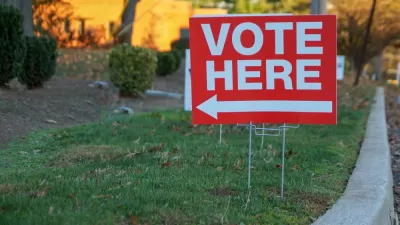Young adults, according to a deep dive analysis by Brookings Metro demographer William Frey, were a key demographic group responsible for stopping the red wave that most polling predicted as the likely outcome of last month's midterm elections.

William H. Frey, a senior fellow with Brookings Metro, analyzed the midterm elections both before and after November 8. He wrote on November 18 in his deep dive on the outcome:
In order to better understand how Democrats avoided big losses in the 2022 midterms, this analysis examines Democratic minus Republican (D-R) vote margins using 2022 exit polls data and those of earlier elections compiled by Edison Research.
They show that among people voting for House of Representatives candidates, key demographic groups that traditionally favor Democrats (young people, women, racial minorities, and white female college graduates) played a significant role.
The group that stands out are “young adults,” observes Frey, when compared with the “2020 presidential election or previous midterms.”
Avoid ‘Nationalizing’ the Election
Frey makes the same point that Nate Cohn, The New York Times’s chief political analyst, made about the importance of looking at the election results statewide, thus avoiding the tendency to “nationalize” election results.
Cohn wrote on November 11, well before many of the election results were finalized (Italics added):
The results by state only add to the uncommon picture. In our era of increasingly nationalized elections, trends in one part of the country tend to play out in others as well. Instead, this year we saw a split: Republicans fared exceptionally well in some states, including Florida and New York. In others, like Michigan or Pennsylvania, Democrats excelled.
Similarly, Frey wrote, “While most national demographic voter patterns hold, there are key differences across states. Some of these are accentuated in elections with strong partisan results, such as the gubernatorial contests in Pennsylvania and Florida.”
Age Matters
Cohn went on to expound on two key issues: abortion and ‘democracy’—how they played differently on a state basis. The former also played a significant role in Frey's analysis on the voting patterns of demographic groups.
Among the youngest Americans, Democrats have held an advantage in votes for House of Representatives candidates in every midterm or presidential election since the late 1990s. Yet in 2022, the 18- to 29-year-old age group (made up of Gen Z and the youngest millennials) showed an even more pronounced shift toward Democrats.
Especially important to this youth vote is the contribution of young women. Prior to last week’s election, there was much speculation about how the Supreme Court’s decision to overturn Roe v. Wade would affect women’s voting patterns. The new exit polls show that 47% of female voters felt angry about that decision, and 83% of those women voted for a Democratic candidate.
On the other end of the political and age spectrum, “[a]mong voters over age 45, both men and women were less likely to vote Democratic in 2022 than in 2020,” adds Frey. “Thus, a good part of the women’s vote for Democrats was accentuated by young people.”
Future Voting Patterns
In the first of three concluding points, Frey writes:
Still, the demographic patterns revealed by these exit polls hold some expectations for the future. Perhaps most important is the strong Democratic support from young people—men, women, and people of color—to a level that most analysts did not predict. For a variety of reasons—including concerns about abortion, inclusivity, democracy, and education—it seems likely that Gen Z and young millennials will become the future core of the Democratic coalition.
And notes in his final paragraph:
In short, these midterms revealed Democrats’ strength among new generations of voters and demographic groups that will continue to grow in size [pdf], while Republicans continue to do well with older voters and white men without college educations.
More on the Midterms on Planetizen:
- 2022 Midterm Election Results for Land Use, Transportation, and the Climate, November 9, 2022
- Western Voters: Yes to Conservation, No to Extremism, November 29, 2022
- The Elections and Transportation, November 8, 2022
- No Bragging Rights for Passing the Infrastructure Act? November 8, 2022
- The Republican Energy and Climate Agenda, November 6, 2022
FULL STORY: Midterm exit polls show that young voters drove Democratic resistance to the ‘red wave’

Planetizen Federal Action Tracker
A weekly monitor of how Trump’s orders and actions are impacting planners and planning in America.

Chicago’s Ghost Rails
Just beneath the surface of the modern city lie the remnants of its expansive early 20th-century streetcar system.

San Antonio and Austin are Fusing Into one Massive Megaregion
The region spanning the two central Texas cities is growing fast, posing challenges for local infrastructure and water supplies.

Since Zion's Shuttles Went Electric “The Smog is Gone”
Visitors to Zion National Park can enjoy the canyon via the nation’s first fully electric park shuttle system.

Trump Distributing DOT Safety Funds at 1/10 Rate of Biden
Funds for Safe Streets and other transportation safety and equity programs are being held up by administrative reviews and conflicts with the Trump administration’s priorities.

German Cities Subsidize Taxis for Women Amid Wave of Violence
Free or low-cost taxi rides can help women navigate cities more safely, but critics say the programs don't address the root causes of violence against women.
Urban Design for Planners 1: Software Tools
This six-course series explores essential urban design concepts using open source software and equips planners with the tools they need to participate fully in the urban design process.
Planning for Universal Design
Learn the tools for implementing Universal Design in planning regulations.
planning NEXT
Appalachian Highlands Housing Partners
Mpact (founded as Rail~Volution)
City of Camden Redevelopment Agency
City of Astoria
City of Portland
City of Laramie





























